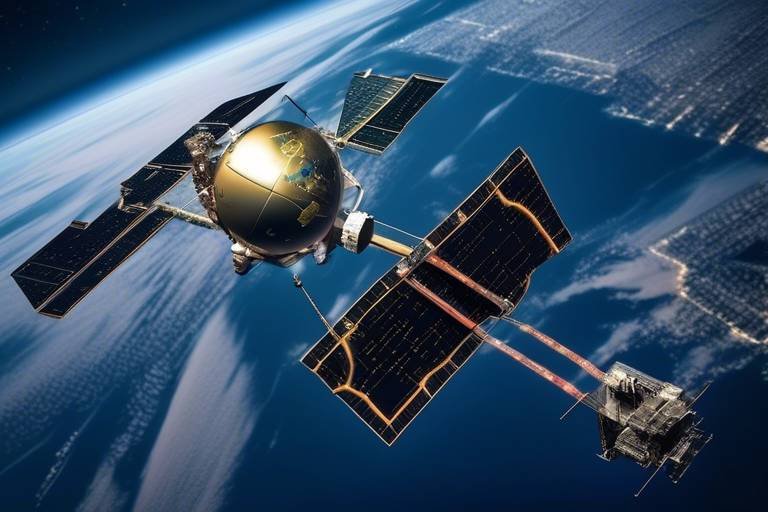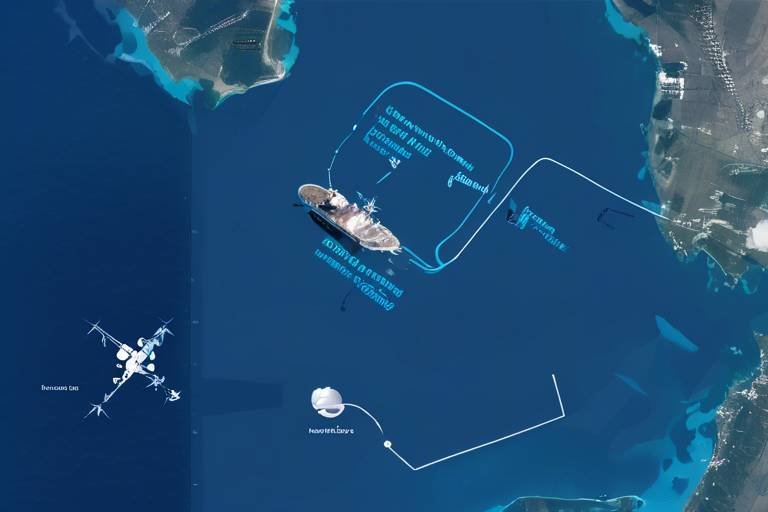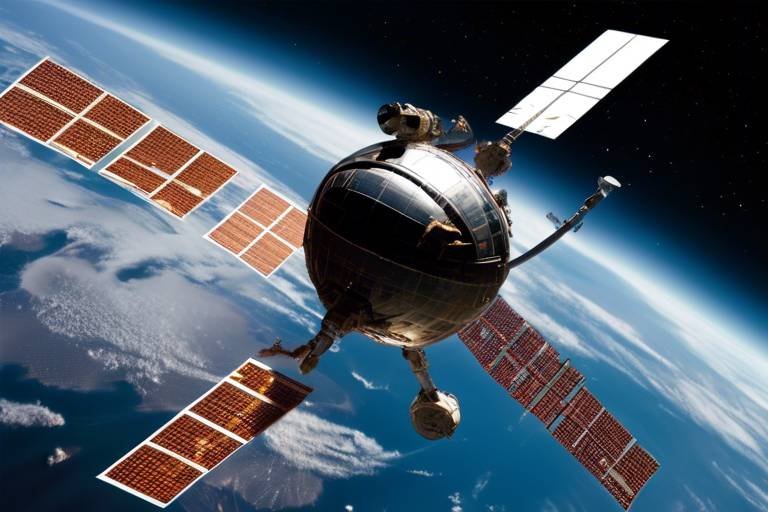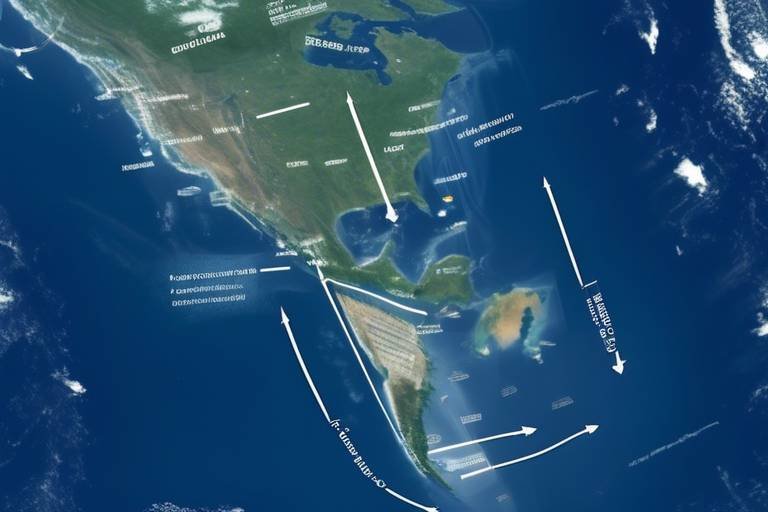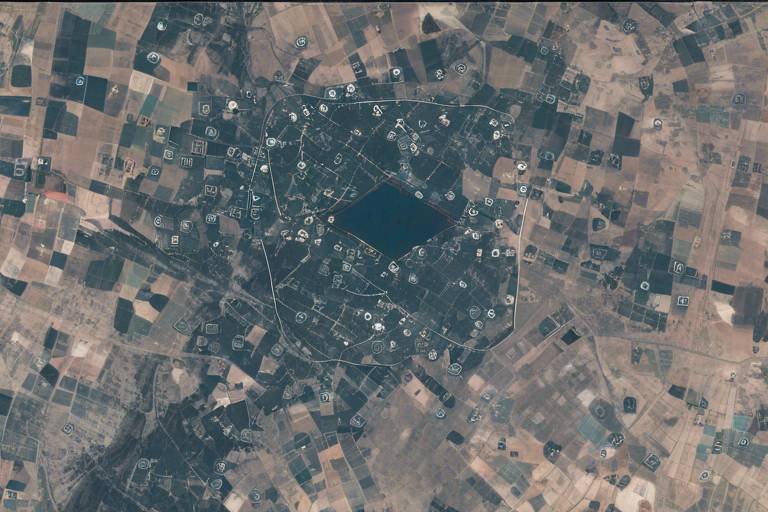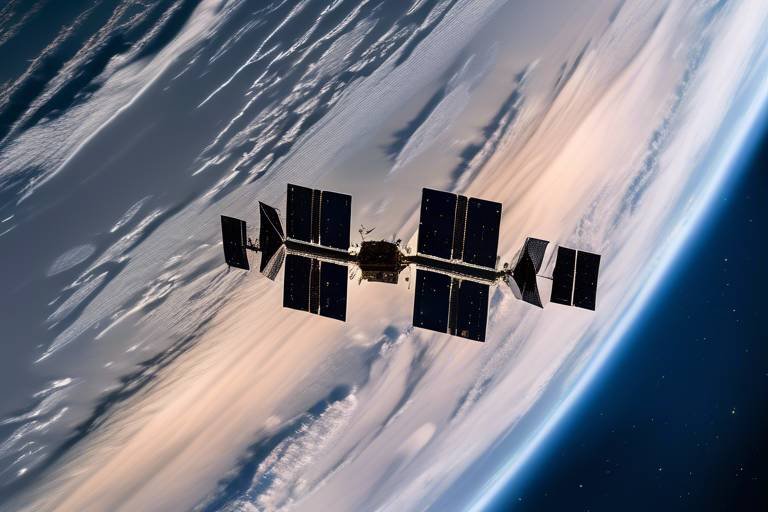How Satellites Improve Information Sharing Among Forces
This article explores the critical role satellites play in enhancing communication and information exchange among military forces, leading to improved operational effectiveness and decision-making in various scenarios. In a world where every second counts, the ability to share information swiftly and accurately can mean the difference between success and failure on the battlefield. Imagine a vast network of eyes in the sky, constantly observing and relaying vital information to ground troops, air support, and command centers. This is the power of satellites, and it’s revolutionizing the way military operations are conducted.
Satellites provide robust communication systems that enable real-time data sharing, allowing military units to maintain coordination and respond quickly to evolving situations on the battlefield. Picture a scenario where a unit in the field encounters unexpected resistance. With satellite communication, they can instantly relay their situation back to command, ensuring that reinforcements or tactical support can be dispatched without delay. This immediacy not only enhances operational efficiency but also significantly reduces the risks faced by troops on the ground.
With their ability to cover vast geographic areas, satellites ensure that even remote or inaccessible locations are connected, facilitating information flow across diverse terrains and environments. Whether it’s the dense jungles of Southeast Asia or the arid deserts of the Middle East, satellites bridge the communication gap. This global coverage means that military forces can operate in coordination, regardless of their location. In fact, a single satellite can provide coverage to an area the size of a small country, making it an invaluable asset for modern warfare.
The use of satellites grants military forces the flexibility to adapt their strategies and operations in real-time, making it easier to respond to unexpected challenges or threats. Imagine a chess game where you can see your opponent’s every move; this is the level of insight satellites provide. This operational flexibility allows commanders to make informed decisions quickly, adjusting tactics on the fly based on the latest intelligence.
Satellites allow for instant access to critical data, empowering decision-makers with the information needed to make timely and informed choices during missions. The ability to access data in real-time means that military leaders can evaluate situations as they unfold, rather than relying on outdated or incomplete information. This real-time access is crucial during high-stakes operations where every second can impact the outcome.
Satellite communication systems can integrate with various military technologies, enhancing collaboration between different branches of the armed forces and allied nations. This interoperability is essential in joint operations, where forces from multiple countries work together. By ensuring that all parties have access to the same information, satellites help to foster cooperation and unity of effort, which is vital for mission success.
Satellites play a vital role in intelligence operations, providing surveillance capabilities that help monitor enemy movements and gather crucial information for strategic planning. Think of satellites as the watchful sentinels of the sky, constantly scanning for any signs of activity. This capability enables military planners to anticipate enemy actions and make proactive decisions, rather than merely reacting to threats as they arise.
Satellites enhance situational awareness by providing comprehensive data on troop movements, environmental conditions, and potential threats, allowing forces to operate with greater insight and foresight. The information gathered from satellites can be analyzed to create detailed maps and models, giving commanders a clearer picture of the battlefield. This enhanced situational awareness is akin to having a high-definition view of a blurry landscape, allowing for better decision-making and strategy formulation.
The integration of satellite data with analytical tools enables military leaders to assess situations more accurately and develop effective responses based on real-time information. With advanced algorithms and data processing capabilities, military forces can transform raw satellite data into actionable intelligence, helping to streamline operations and reduce uncertainty in decision-making.
Advancements in satellite technology promise to further enhance information sharing capabilities, including developments in miniaturization, increased bandwidth, and improved resilience against electronic warfare. As technology continues to evolve, we can expect satellites to become even more integral to military operations, providing faster, more reliable communication channels and better data analysis tools.
- How do satellites communicate with ground forces?
Satellites use radio waves to transmit data back and forth between ground stations and military units, enabling real-time communication. - What types of data can satellites collect?
Satellites can collect a variety of data, including imagery, environmental conditions, and signals intelligence, which can be crucial for military operations. - Are satellites vulnerable to attacks?
Yes, satellites can be vulnerable to electronic warfare and cyber attacks, which is why resilience and security measures are continuously being improved. - How does satellite technology impact joint military operations?
Satellite technology enhances coordination and communication among different military branches and allied nations, improving overall mission effectiveness.
Enhanced Communication Capabilities
In today's fast-paced world, where every second counts, communication is the lifeline that connects military forces to their operational success. Satellites have revolutionized this aspect, providing robust communication systems that enable real-time data sharing across vast distances. Imagine being on a battlefield where decisions need to be made in the blink of an eye. Thanks to satellite technology, military units can maintain seamless coordination, ensuring that they respond swiftly to evolving situations.
One of the standout features of satellite communication is its ability to transmit data regardless of geographical barriers. Whether troops are stationed in the heart of a bustling city or in the remote wilderness, satellites ensure that they are never out of touch. This capability is particularly crucial in combat scenarios where timely information can mean the difference between success and failure. For instance, during a military operation, if one unit encounters unexpected enemy forces, they can instantly relay this information to command centers and allied units, allowing for a coordinated response.
Moreover, the integration of advanced technology in satellite systems has led to enhanced data transmission rates, which means that not only can troops communicate verbally, but they can also share critical data such as maps, images, and even video feeds. This multi-faceted approach to communication provides a comprehensive picture of the battlefield, enabling military leaders to make informed decisions quickly. In a world where every moment is crucial, the ability to access and share information instantaneously is invaluable.
Furthermore, the interoperability of satellite communication systems with other military technologies is a game-changer. This means that different branches of the armed forces, whether it's the Army, Navy, or Air Force, can communicate effortlessly. For example, a naval vessel can share reconnaissance data with ground troops, enhancing overall operational effectiveness. The synergy created through this interconnectedness allows for a more cohesive approach to military operations, ultimately leading to better outcomes on the battlefield.
In summary, the enhanced communication capabilities provided by satellites are a cornerstone of modern military operations. They not only facilitate real-time data sharing but also ensure that forces can adapt to changing circumstances swiftly. As we look to the future, the continuous advancements in satellite technology promise even greater improvements in communication, making it an exciting time for military strategists and personnel alike.
Global Coverage and Reach
When we think about the vastness of our planet, it becomes evident that effective communication in remote and challenging environments is no small feat. This is where satellites come into play, acting as the unsung heroes of military operations. They provide a global coverage that ensures no matter where military forces are deployed—be it the icy tundras of the Arctic, the dense jungles of the Amazon, or the arid deserts of the Middle East—communication remains uninterrupted. Imagine trying to coordinate a rescue mission in a remote area without reliable communication; it would be like navigating a ship without a compass. Satellites eliminate this uncertainty by bridging the communication gap.
One of the most impressive aspects of satellite technology is its ability to connect diverse terrains and environments. Whether it's a mountainous region where radio waves struggle to penetrate or an oceanic expanse where traditional communication methods fail, satellites ensure that military units can share critical information in real-time. This capability is not just a luxury; it is a necessity for operational success. For instance, during joint exercises involving multiple nations, satellites facilitate seamless communication, allowing forces to operate as a cohesive unit despite being thousands of miles apart.
Furthermore, the reach of satellites extends beyond mere communication. They also provide essential data on weather patterns, environmental conditions, and terrain analysis, all of which are crucial for mission planning. With satellites providing a bird’s eye view of the battlefield, commanders can make informed decisions based on comprehensive data rather than relying on fragmented information. This access to real-time data enhances operational effectiveness, allowing forces to adapt their strategies on the fly.
To illustrate the importance of global coverage, consider the following table that highlights some key aspects of satellite communication:
| Aspect | Impact on Military Operations |
|---|---|
| Real-Time Communication | Enables rapid coordination and response to evolving threats. |
| Data Accessibility | Provides critical information for strategic planning and execution. |
| Operational Reach | Ensures connectivity in remote and inaccessible locations. |
| Environmental Monitoring | Offers insights into weather and terrain, aiding mission success. |
In conclusion, the global coverage and reach of satellites are pivotal in enhancing military operations. They serve as the backbone of communication, ensuring that forces can maintain coordination and adapt to changing situations effectively. Without this technological marvel, the complexities of modern warfare would be insurmountable. It's clear that as we move forward, the role of satellites will only continue to grow, further solidifying their importance in military strategy and operations.
- How do satellites improve military communication?
Satellites enable real-time data sharing and connectivity across vast distances, allowing military units to coordinate effectively. - What are the benefits of global satellite coverage?
Global coverage ensures that even remote areas are connected, enhances situational awareness, and provides critical data for decision-making. - Can satellites operate in extreme weather conditions?
Yes, satellites are designed to function in various weather conditions, ensuring reliable communication regardless of environmental challenges.
Operational Flexibility
In the ever-evolving landscape of modern warfare, is not just a luxury; it’s a necessity. Satellites provide military forces with the ability to adapt their strategies and operations in real-time, which is crucial when unexpected challenges arise. Imagine a chess game where every move can change the entire board's dynamics—this is similar to how military operations function when they leverage satellite technology. With the ability to receive and transmit real-time data, commanders can make informed decisions that reflect the current battlefield conditions.
For instance, consider a scenario where a unit encounters an unforeseen threat while on a mission. Traditional communication methods may falter, but with satellite systems in place, they can quickly relay their position and request immediate support. This not only enhances their safety but also allows for a swift tactical response from nearby forces, ensuring that they can adapt to the situation without missing a beat.
Furthermore, satellites enable seamless communication across various terrains, whether it’s dense urban environments or remote wilderness. This capability allows different branches of the military to coordinate their efforts effectively. When units can share intelligence and operational updates instantly, they can adjust their tactics on the fly, ensuring that they are always one step ahead of the enemy.
To illustrate this point, let’s look at a few key aspects of how satellites contribute to operational flexibility:
- Real-Time Updates: With satellite communications, units receive immediate updates about changing conditions, enemy movements, and logistical needs.
- Cross-Branch Coordination: Satellites allow different military branches to collaborate more effectively, sharing crucial information that can dictate the success of a mission.
- Rapid Deployment: Forces can be repositioned quickly based on satellite data, ensuring that reinforcements arrive where they are needed most.
In conclusion, the operational flexibility afforded by satellite technology is transformative. It empowers military forces to respond dynamically to threats and challenges, enhancing their overall effectiveness in complex environments. As we continue to explore the capabilities of satellite systems, one thing is clear: the future of military operations will increasingly rely on the agility that satellites provide.
Q1: How do satellites enhance communication in military operations?
A1: Satellites enable real-time communication and data sharing, allowing military units to coordinate effectively and respond quickly to changing situations.
Q2: What role do satellites play in intelligence gathering?
A2: Satellites provide critical surveillance capabilities, monitoring enemy movements and gathering information necessary for strategic planning.
Q3: Can satellite technology be integrated with other military systems?
A3: Yes, satellite communication systems can seamlessly integrate with various military technologies, enhancing collaboration among different branches and allied nations.
Q4: What are the future trends in satellite technology for military use?
A4: Future advancements include miniaturization, increased bandwidth, and improved resilience against electronic warfare, all of which will enhance information sharing capabilities.
Real-Time Data Access
In the fast-paced world of military operations, is not just a luxury; it's a necessity. Imagine being in the middle of a crucial mission, and suddenly, you need to make a split-second decision that could determine the outcome of the entire operation. This is where the power of satellites shines brightly. They provide instantaneous access to critical information, allowing commanders and troops to stay informed and responsive to the ever-changing dynamics of the battlefield.
Satellites facilitate a seamless flow of information, bridging the gap between various military units and command centers. This connectivity means that no matter where troops are deployed—be it a dense jungle, a vast desert, or an urban landscape—vital data is just a click away. For instance, consider a scenario where ground troops encounter unexpected enemy movements. With satellite technology, they can instantly relay their observations to higher command, who can then analyze the situation and deploy reinforcements or change strategies in real-time. This level of responsiveness can be the difference between success and failure in critical missions.
Moreover, the integration of satellite data with advanced analytical tools enhances decision-making processes. Military leaders can access not only raw data but also sophisticated analyses that interpret this information. For example, a satellite might capture imagery of enemy positions, which can then be processed to identify troop concentrations or potential vulnerabilities. This combination of real-time access and analytical capability allows for more informed and strategic decisions.
To illustrate the impact of real-time data access, consider the following table that highlights the advantages of satellite communication in military operations:
| Advantage | Description |
|---|---|
| Instant Communication | Allows immediate sharing of critical information across units. |
| Data Integration | Combines satellite data with other intelligence sources for comprehensive insights. |
| Enhanced Coordination | Facilitates better collaboration among different branches of the military. |
| Rapid Response | Enables quick adjustments to strategies based on real-time conditions. |
As we look to the future, the capabilities of satellites in providing real-time data access will only continue to expand. With advancements in technology, we can expect even more robust systems that will enhance the speed and accuracy of information sharing among military forces. This evolution will empower troops on the ground and decision-makers in command centers, ultimately leading to more effective and strategic military operations.
- How do satellites provide real-time data access? Satellites use advanced communication technologies to transmit data instantly from remote locations to command centers, ensuring timely information flow.
- What types of data can be accessed in real-time? Military forces can access various data types, including surveillance imagery, troop movements, environmental conditions, and logistical information.
- Are there limitations to satellite communication? Yes, factors such as weather conditions, satellite positioning, and electronic interference can impact the quality of satellite communications.
- How does real-time data access improve military operations? It enhances situational awareness, allows for rapid decision-making, and improves coordination among different military units.
Interoperability with Other Systems
The concept of interoperability in military operations is crucial, especially when considering the diverse array of technologies used by different branches of the armed forces. Satellites serve as a backbone for this interoperability, allowing various systems to communicate seamlessly. Imagine a well-orchestrated symphony where each instrument plays its part in harmony; this is how satellite communication integrates with other military technologies. By enabling different platforms—be it air, land, or sea—to share information in real-time, satellites enhance the overall effectiveness of military operations.
For instance, when ground troops need immediate air support, satellite systems can relay information about troop locations and enemy positions directly to aircraft, ensuring that pilots have the most current data at their fingertips. This kind of integration not only streamlines communication but also reduces the time it takes to make critical decisions. In a world where seconds can mean the difference between success and failure, this capability is invaluable.
Moreover, the interoperability of satellite communication systems extends beyond domestic forces. It plays a significant role in multinational operations where allied nations must work together. Imagine a joint task force composed of forces from multiple countries; without effective communication, coordination would be nearly impossible. Satellites bridge this gap, allowing for the sharing of intelligence and operational data across borders. This collaboration not only strengthens alliances but also enhances collective security.
To illustrate the importance of interoperability, consider the following table that outlines key systems that benefit from satellite communication:
| Military Branch | System | Interoperability Benefit |
|---|---|---|
| Army | Ground Command Systems | Real-time troop and asset tracking |
| Air Force | Combat Aircraft | Direct communication for air support |
| Navy | Naval Vessels | Coordinated operations in maritime environments |
| Joint Forces | Allied Command Systems | Shared intelligence and operational data |
In conclusion, the interoperability facilitated by satellite communication is not just a technological advantage; it is a strategic necessity. As military operations become increasingly complex, the ability to integrate diverse systems and share information across platforms will be paramount to success. The future of military operations lies in the hands of those who can harness the power of satellite technology to create a cohesive and responsive force.
- What is interoperability in military terms?
Interoperability refers to the ability of different military systems, units, or organizations to work together effectively through shared communication and data exchange. - How do satellites improve military communication?
Satellites provide real-time data sharing capabilities, allowing military units to communicate instantly, regardless of geographic location. - What are some examples of systems that use satellite communication?
Examples include ground command systems, combat aircraft, naval vessels, and allied command systems. - Why is interoperability important in joint operations?
Interoperability ensures that forces from different countries can coordinate effectively, share intelligence, and respond to threats in a unified manner.
Intelligence Gathering and Surveillance
In the realm of modern warfare, have become the backbone of strategic operations. Satellites are not just orbiting pieces of technology; they are the eyes in the sky, providing a bird’s-eye view of the battlefield. Imagine trying to navigate a maze without being able to see the paths ahead—this is what military forces would face without satellite capabilities. By leveraging satellite technology, military forces can monitor enemy movements and gather crucial information that informs their strategies and decisions.
Satellites equipped with advanced imaging technologies, such as synthetic aperture radar (SAR) and electro-optical sensors, can capture detailed images of ground activities, even in adverse weather conditions. This capability allows for continuous surveillance, ensuring that commanders have real-time visibility over critical areas of interest. For example, if an enemy force is amassing troops or equipment, satellites can detect these movements long before they become a threat, giving military planners the time to devise appropriate responses.
Moreover, the data collected from satellite surveillance can be integrated with other intelligence sources, such as aerial reconnaissance and ground reports, to create a comprehensive picture of the operational environment. This multilayered approach to intelligence gathering enhances situational awareness, allowing forces to stay one step ahead of potential adversaries. It’s akin to piecing together a puzzle; each piece of information adds clarity to the overall picture, enabling better decision-making.
To illustrate the impact of satellite surveillance, consider the following table that outlines some of the key capabilities and benefits:
| Capability | Benefit |
|---|---|
| Real-Time Imaging | Immediate visibility of enemy movements and activities. |
| Wide Area Coverage | Ability to monitor vast geographic regions simultaneously. |
| All-Weather Operations | Continuous surveillance regardless of environmental conditions. |
| Data Integration | Combining satellite data with other intelligence sources for enhanced analysis. |
In addition to monitoring troop movements, satellites also play a critical role in gathering signals intelligence (SIGINT). By intercepting communications and electronic signals, satellites provide insights into enemy plans and intentions. This capability is especially vital in countering asymmetric threats, where understanding the enemy's communication patterns can lead to preemptive actions. Think of it as having a secret decoder ring that reveals what the enemy is planning before they even execute their strategies.
As we look towards the future, the role of satellites in intelligence gathering and surveillance is expected to expand even further. With advancements in miniaturization and artificial intelligence, future satellites will be able to process data more efficiently and provide even more accurate intelligence in real-time. This evolution will not only enhance operational effectiveness but also reshape the way military forces conduct their missions in an increasingly complex global landscape.
- How do satellites contribute to military intelligence? Satellites provide real-time data and imagery that help monitor enemy movements and gather essential information for strategic planning.
- What technologies do satellites use for surveillance? Satellites utilize synthetic aperture radar, electro-optical sensors, and signals intelligence capabilities to gather comprehensive data.
- Can satellites operate in bad weather? Yes, many satellite systems are designed to function effectively in various weather conditions, ensuring continuous surveillance.
- How does satellite data integrate with other intelligence sources? Satellite data can be combined with aerial reconnaissance and ground intelligence to create a more complete operational picture.
Improved Situational Awareness
In the fast-paced world of military operations, the ability to maintain can be the difference between success and failure. Satellites play a pivotal role in this aspect by providing a continuous stream of data that informs commanders about troop movements, environmental conditions, and potential threats. Imagine being in a vast ocean without a map; that’s how chaotic military operations would be without satellite technology. With satellites, military forces gain a comprehensive view of the battlefield, akin to having a bird's eye perspective that allows them to see the bigger picture and make informed decisions.
One of the most significant contributions of satellites to situational awareness is their capacity to collect and relay real-time data. This data includes everything from weather patterns to enemy positions, which can be crucial for planning and executing operations. For instance, if a military unit is preparing for an aerial assault, knowing the current weather conditions can be vital. A sudden storm could ground aircraft, leading to a mission failure. Satellites mitigate these risks by providing timely and accurate weather updates, allowing forces to adapt their strategies accordingly.
Moreover, the integration of satellite data with advanced analytical tools enhances decision-making processes. Military leaders can visualize data in dynamic formats, such as 3D maps and heat maps, which illustrate troop movements and highlight areas of concern. This visualization aids in quickly identifying patterns and trends, enabling commanders to make strategic decisions with confidence. For example, if satellite imagery reveals an unusual concentration of enemy forces in a specific area, military leaders can swiftly redirect resources and adjust their tactics to counter potential threats.
To illustrate the importance of satellites in improving situational awareness, consider the following table that summarizes key features and benefits:
| Feature | Benefit |
|---|---|
| Real-time data collection | Allows for immediate response to changing battlefield conditions |
| Comprehensive surveillance | Enables monitoring of enemy movements and strategic planning |
| Weather updates | Informs operational readiness and planning |
| Data visualization tools | Enhances understanding of complex battlefield dynamics |
Additionally, satellites facilitate communication among different branches of the armed forces, ensuring that everyone is on the same page. This interoperability is vital in joint operations where multiple units must collaborate seamlessly. Imagine trying to coordinate a large-scale military exercise without a shared view of the battlefield; chaos would ensue. Satellites eliminate this risk by providing a unified platform for information sharing, enhancing overall situational awareness.
In conclusion, the role of satellites in improving situational awareness cannot be overstated. They provide military forces with the tools needed to operate effectively in complex environments, ensuring that leaders have the information required to make timely and informed decisions. As technology continues to evolve, the capabilities of satellites will only expand, further enhancing the ability of military forces to maintain situational awareness and respond to threats with agility and precision.
- How do satellites improve communication in military operations? Satellites provide robust communication systems that enable real-time data sharing, allowing for quick coordination among military units.
- What types of data do satellites collect for situational awareness? Satellites collect various data, including troop movements, weather conditions, and environmental factors that can impact military operations.
- Can satellite data be integrated with other military technologies? Yes, satellite communication systems can integrate with various military technologies, enhancing collaboration across different branches of the armed forces.
- What future advancements can we expect in satellite technology? Future trends include miniaturization, increased bandwidth, and improved resilience against electronic warfare, which will further enhance information sharing capabilities.
Data Analysis and Decision Support
In the fast-paced world of military operations, the ability to analyze data swiftly and effectively can mean the difference between success and failure. Data analysis is not just about numbers and statistics; it's about transforming raw information into actionable insights that can guide critical decisions on the battlefield. With the integration of satellite data into military operations, forces now have access to a wealth of information that can be analyzed in real-time, providing commanders with the tools they need to make informed choices.
Imagine being in a chaotic situation where every second counts. The ability to quickly process satellite imagery and data feeds can illuminate the battlefield, revealing enemy positions, troop movements, and environmental conditions. This is where decision support systems come into play. By leveraging advanced analytical tools, military leaders can synthesize information from various sources, including satellite data, to get a comprehensive view of the operational landscape.
One of the most significant advantages of using satellite data for analysis is its ability to provide a holistic view of a situation. For example, consider a scenario where ground forces are engaged in a conflict in a remote area. The integration of satellite imagery with other intelligence sources allows commanders to:
- Monitor troop movements in real-time
- Assess environmental impacts on operations
- Identify potential threats before they become critical
This comprehensive understanding enables military leaders to adapt their strategies dynamically, ensuring that they remain one step ahead of their adversaries. Furthermore, the use of machine learning algorithms and artificial intelligence can enhance the analysis process, allowing for predictive modeling that anticipates enemy actions based on historical data.
To illustrate the impact of data analysis on decision-making, consider the following table that summarizes the key benefits of integrating satellite data into military operations:
| Benefit | Description |
|---|---|
| Real-Time Insights | Immediate access to data enables timely decision-making. |
| Enhanced Accuracy | Data-driven insights reduce the risk of human error. |
| Predictive Analysis | Anticipates enemy movements and strategies based on data trends. |
| Improved Coordination | Facilitates better communication and collaboration among units. |
In conclusion, the integration of satellite data into military operations not only enhances situational awareness but also significantly improves decision-making processes. The ability to analyze vast amounts of data quickly and accurately empowers military leaders to respond to challenges effectively, ensuring that they are well-equipped to navigate the complexities of modern warfare.
- How do satellites enhance military communication?
Satellites provide robust and reliable communication systems that enable real-time data sharing, ensuring that military units can coordinate their efforts effectively. - What role does data analysis play in military strategy?
Data analysis transforms raw satellite information into actionable insights, helping military leaders make informed decisions based on real-time data. - Can satellite data be integrated with other military technologies?
Yes, satellite communication systems can work alongside various military technologies, enhancing interoperability among different branches of the armed forces. - What are the future trends in satellite technology?
Future advancements may include increased bandwidth, improved resilience against electronic warfare, and further miniaturization of satellite systems.
Future Trends in Satellite Technology
This article explores the critical role satellites play in enhancing communication and information exchange among military forces, leading to improved operational effectiveness and decision-making in various scenarios.
Satellites provide robust communication systems that enable real-time data sharing, allowing military units to maintain coordination and respond quickly to evolving situations on the battlefield.
With their ability to cover vast geographic areas, satellites ensure that even remote or inaccessible locations are connected, facilitating information flow across diverse terrains and environments.
The use of satellites grants military forces the flexibility to adapt their strategies and operations in real-time, making it easier to respond to unexpected challenges or threats.
Satellites allow for instant access to critical data, empowering decision-makers with the information needed to make timely and informed choices during missions.
Satellite communication systems can integrate with various military technologies, enhancing collaboration between different branches of the armed forces and allied nations.
Satellites play a vital role in intelligence operations, providing surveillance capabilities that help monitor enemy movements and gather crucial information for strategic planning.
Satellites enhance situational awareness by providing comprehensive data on troop movements, environmental conditions, and potential threats, allowing forces to operate with greater insight and foresight.
The integration of satellite data with analytical tools enables military leaders to assess situations more accurately and develop effective responses based on real-time information.
As we look to the future, the landscape of satellite technology is evolving at an unprecedented pace. One of the most exciting trends is miniaturization. Smaller satellites, often referred to as CubeSats, are being developed to carry out specific missions without the need for large, expensive units. These miniaturized satellites can be deployed in swarms, providing a network of data collection points that can enhance situational awareness.
Another trend is the increase in bandwidth. With the demand for high-speed communication escalating, satellite technology is adapting to provide faster data transfer rates. This is crucial for real-time operations where every second counts. Enhanced bandwidth allows military forces to transmit high-definition imagery and large amounts of data seamlessly, leading to quicker decision-making processes.
Moreover, the resilience of satellite systems against electronic warfare is becoming a focal point of research and development. As adversaries develop countermeasures against traditional satellite communications, the need for more secure and robust systems is paramount. Future satellites will likely incorporate advanced encryption and anti-jamming technologies to ensure uninterrupted service.
In addition, the concept of mega-constellations is gaining traction. Companies like SpaceX and OneWeb are launching thousands of small satellites into low Earth orbit to create a global internet network. This not only provides commercial benefits but also enhances military capabilities by ensuring that forces can communicate and share information from virtually anywhere on the planet.
As we embrace these advancements, it's vital to consider the implications they have on military operations. The future of satellite technology holds the promise of greater efficiency, enhanced security, and improved collaboration among forces, ultimately leading to more effective missions and better outcomes on the battlefield.
- What role do satellites play in military operations? Satellites enhance communication, provide real-time data, and improve situational awareness, enabling effective decision-making.
- How do future trends in satellite technology impact military strategy? Advancements like miniaturization and increased bandwidth allow for more flexible and efficient operations, adapting to real-time challenges.
- What are mega-constellations, and why are they important? Mega-constellations consist of large groups of small satellites that provide global coverage, improving connectivity for military forces.
- How are satellites protected against electronic warfare? Future satellites will incorporate advanced encryption and anti-jamming technologies to safeguard against potential threats.
Frequently Asked Questions
- How do satellites enhance communication among military forces?
Satellites provide robust communication systems that facilitate real-time data sharing. This capability enables military units to maintain coordination and swiftly respond to evolving situations on the battlefield, ensuring that everyone is on the same page, no matter where they are.
- What is the significance of global coverage provided by satellites?
Satellites cover vast geographic areas, which means they can connect even the most remote or inaccessible locations. This global reach is crucial for maintaining a seamless flow of information across diverse terrains and environments, helping forces stay informed and ready to act.
- How do satellites contribute to operational flexibility?
By using satellites, military forces gain the flexibility to adapt their strategies and operations in real-time. This adaptability is vital for responding to unexpected challenges or threats, allowing units to pivot quickly and effectively as situations change.
- What role do satellites play in intelligence gathering?
Satellites are essential for intelligence operations, providing surveillance capabilities that help monitor enemy movements. This information is crucial for strategic planning, enabling military leaders to make informed decisions based on accurate data.
- How do satellites improve situational awareness?
Satellites enhance situational awareness by offering comprehensive data on troop movements, environmental conditions, and potential threats. This wealth of information allows forces to operate with greater insight and foresight, leading to better decision-making.
- What future trends can we expect in satellite technology?
Advancements in satellite technology promise to further improve information sharing capabilities. This includes developments in miniaturization, increased bandwidth, and enhanced resilience against electronic warfare, ensuring that military forces remain connected and effective in the face of new challenges.





